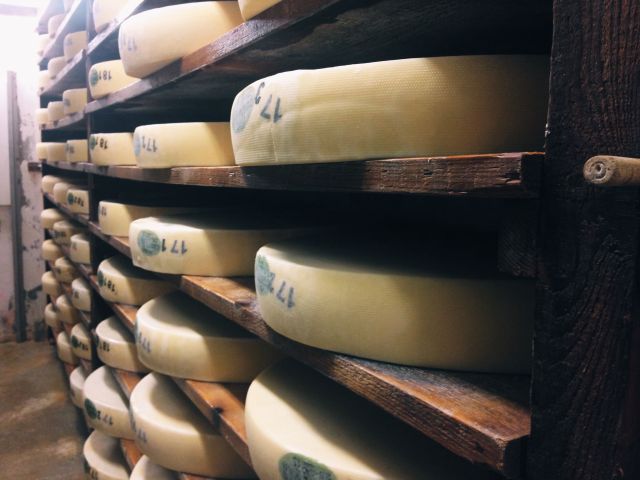Comté cheese just might be the best cheese in France.
Not only is it consistently delicious with an endless diversity of unique tastes and nuanced flavors, it has managed to stay reasonably-priced and serve a mass market without losing its artisanal quality. That’s right – this is a raw milk cheese, made from the milk of grass-fed cows, adhering to very specific regional and national production laws (as in, only one type of wood can be used to age the cheeses on), that produces 60,000 tons per year with a steady 2% growth-rate. “Growth” for Comté does not mean factories, industrialization, vertical integration; it means just the opposite: using industrial technology on a human scale, to increase efficiency without affecting quality.
Comté is an “Appellation d’Origine Protegée” (AOP) Product, which means that it is governed by a specific committee in the French government and must adhere to certain rules. Awarded this status due to its nearly-thousand year history and specific connection to the geography and culture of the region, Comté may only be produced in a 2,000 square mile region. This, understandably, puts some limits on production both economically and physically. Like all AOP products, Comté must be a collective endeavor. This means that no one individual or company may control every part of the production process; farmers must sell their milk to cheese makers, who then sell the young wheels of cheese to agers where they sit for a minimum of four months on planks of regional spruce. There are 2,500 farms, 150 fruitiéres or cheesemaking facilities, and 15 affineurs or aging facilities. Only 15 affineurs putting out 60,000 tons of cheese sounds like an industrial operation; and to a certain extent, industrialization is utilized. There are robots to flip the 80-pound wheels twice a week and wash them in salt rind; computer programs regulate temperatures of the aging caves. But the “chef de cave” still must walk through each aging room, test a wheel or two of cheese, physically gauge whether the temperature and humidity are correct. The industrial element is taken in tandem with a value for human artisanal skill and knowledge, the idea that part of what makes Comté so great is the interaction between nature, culture, and technology.
This idea, in fact, is central to Comté and any other AOP product. The French concept of terroir is one of the guiding principles behind protected agricultural products. Difficult to translate, terroir refers to the specificity of a product based on geographic qualities of the region (soil, weather, flora and fauna, mineral and chemical elements) fused with cultural practices and traditions. This idea of terroir can be felt all throughout the production and consumption of Comté cheese – it comes from the soil, which is irrigated by water carving through limestone deposits in the French Alps; from the cows, which are each given one hectare of wildflower-dotted pasture to roam; from the cheese maker, who has his own specific (although regulated) method for coaxing the milk into curd; from the ager, who has his own “recipe” for the salt wash to form the rind, his own practices and habits. This terroir is translated into taste; each individual wheel of Comté tastes unique, slightly different, depending on a nearly endless variety of factors – the season, the weather, the cheese maker, the milk. This is the beauty of Comté. A mass-produced artisanal cheese with endless diversity of taste seems like an absolute oxymoron. The two do not go together, yet through the values of collectivity, quality, and tradition, Comté persists as it has for the past thousand years.



